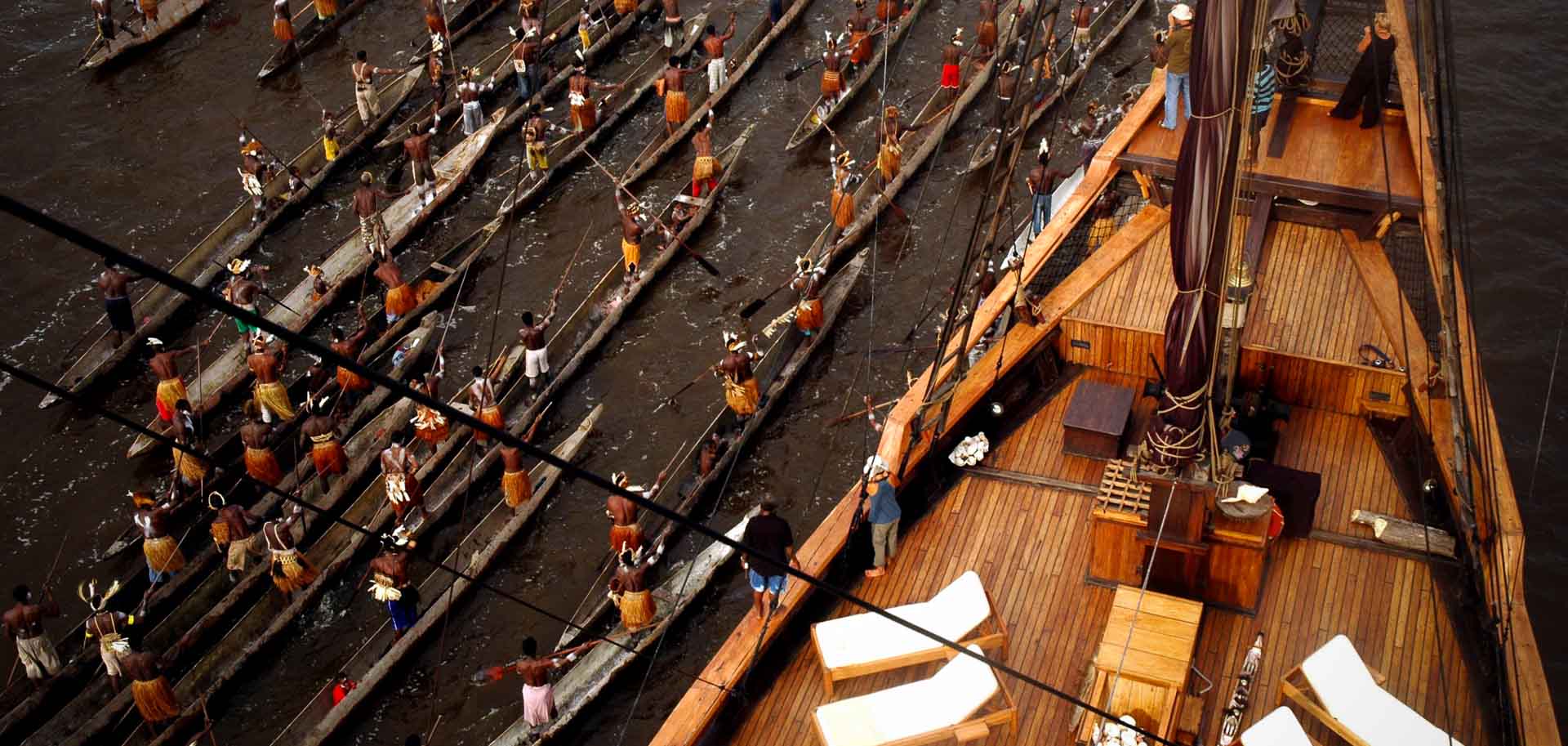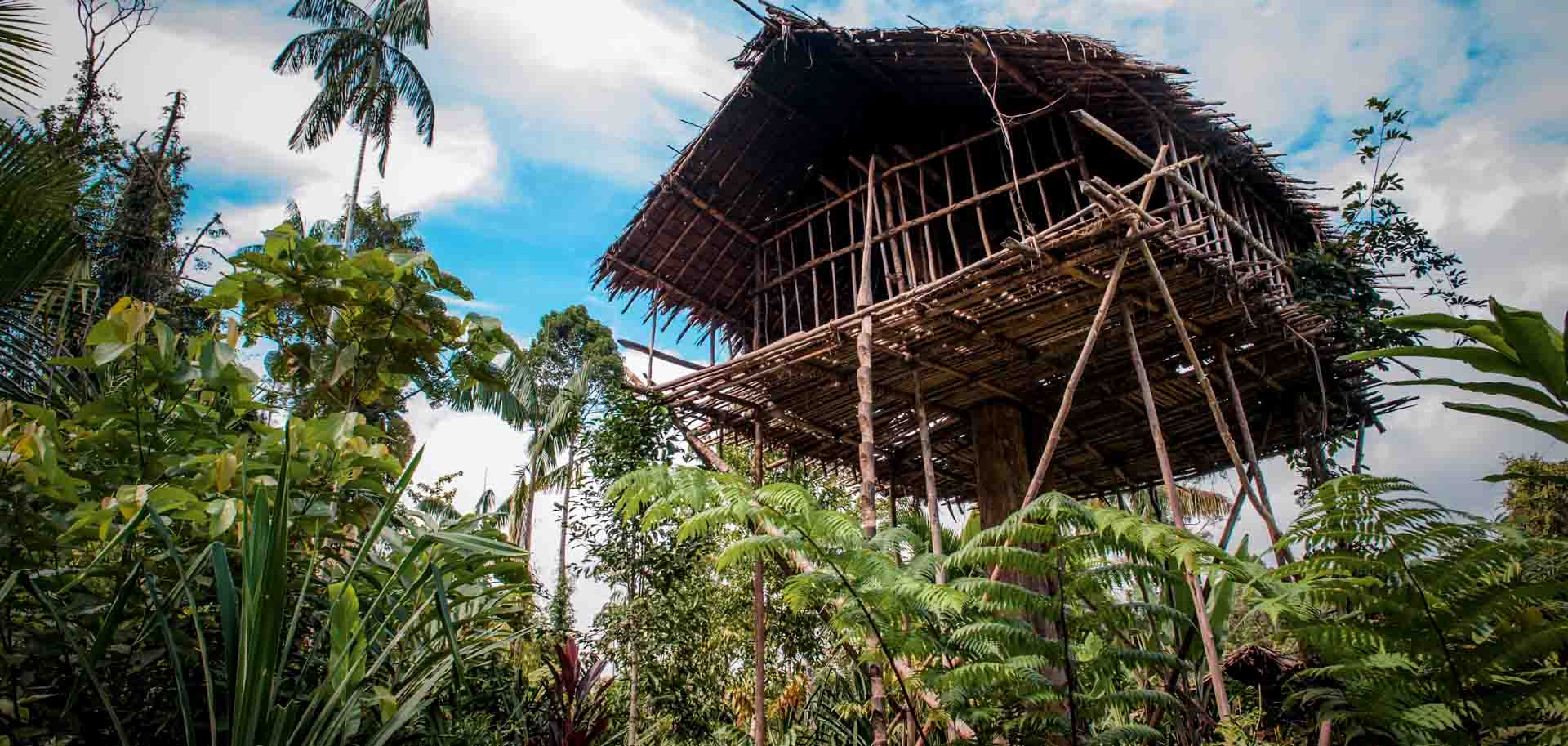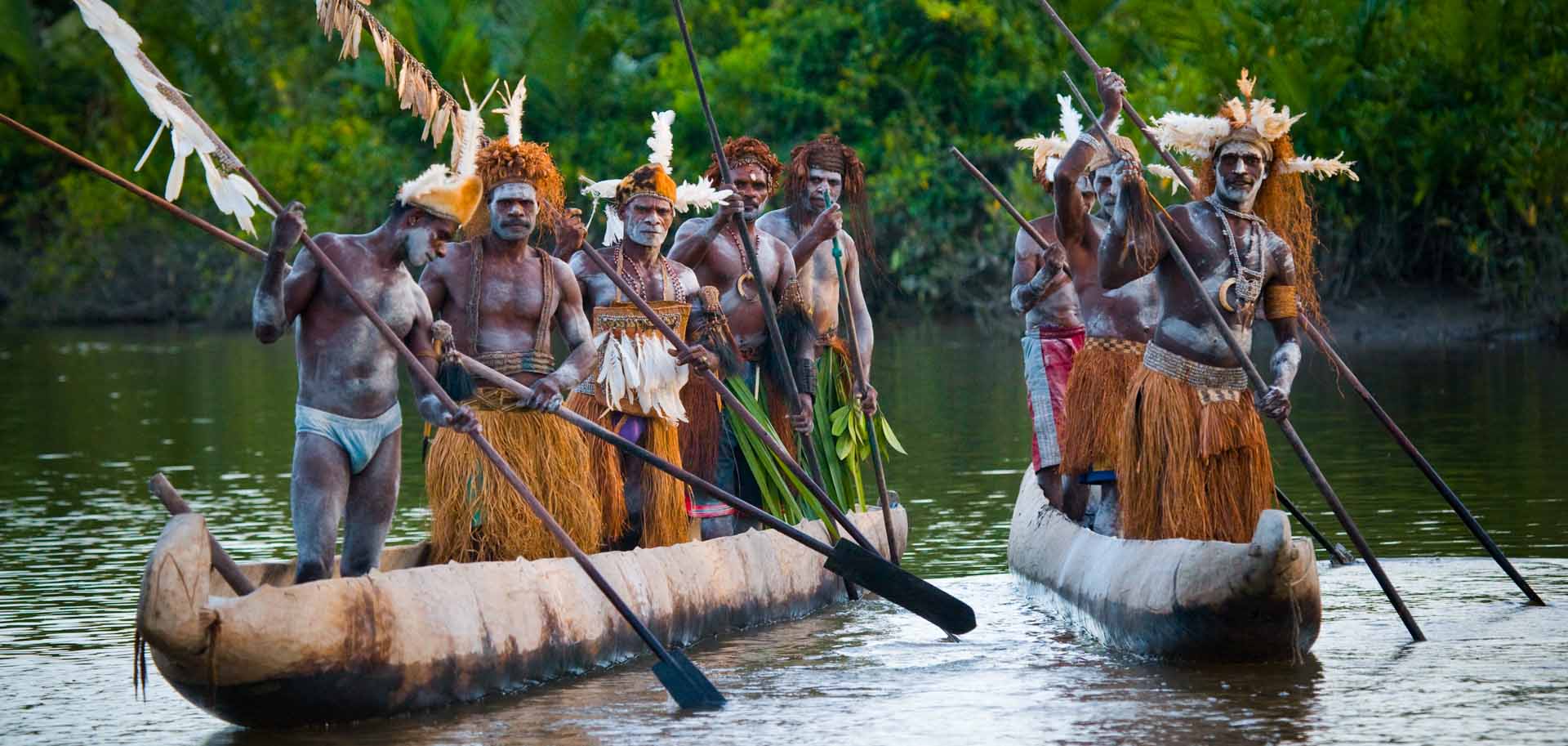
It’s hard to believe that amidst the chaos and clamor of the 21st century, there are still places where people live completely off the land in perfect partnership with nature. West Papua in Indonesia is one of the few places left where the heart of the wild beats undisturbed and ancient cultures practice centuries-old traditions.
The Asmat, Korowai, Kombai, and Dani tribes have thrived here for millennia, retaining their traditional ways of life unaware of the modern world until recent decades. To visit their primitive cultures firsthand is to be transported back in time; to witness their harmonious relationships with Earth and sea is to reawaken one’s own primal connection with nature.
Indo Yachts charters provide guests with expert guides for a personalized introduction to Papuan tribes. Charter guests experience the sensation of exploring region where the only modern comforts are found on board the yacht. A trip to West Papua is a truly unique adventure combining comfort at sea with access to untamed wilderness and the opportunity to visit a captivating region isolated from the modern world.

West Papua is home to more than 250 known Melanesian indigenous ethnic groups, although the true count of tribes is unknown. Explorers and researchers have only recently made contact with the known tribes within the last 30 years, and it’s entirely possible that undocumented tribes exist.
There is a great diversity in Papuan tribes owing to their geographic distance and relative isolation, mirroring the extraordinary biodiversity of their surroundings. Each tribe holds distinct customs and traditions in their greetings, dances, chants, ceremonial rituals and artwork.
Most tribes only began utilizing metal and stone in the last few decades, when foreign explorers introduced the ‘new’ technology. Skipping the Stone Age entirely, they have remained in what scientists have designated the ‘Wood Age’ due to their adept woodworking skills. It is a rare treat for anyone in 2017 to have the chance to glimpse such an ancient way of living.
Throughout its tumultuous history, West Papua has been governed by Spain, France, The Netherlands, Germany, The UK and now Indonesia. With such a range of foreign influence, it is fascinating that the more remote areas have remained unchanged in their old-world practices. In fact, some areas are so remote that some tribal members still remember seeing a white man for the first time.
The Asmat, Korowai and Dani people have had the most contact with the outside world, through visits from explorers and tourists. These tribes embrace the opportunity to interact and to proudly show their way of life to those who venture into their lands.

The Agats region of Papua on the southwestern coast bordering the Arafura Sea consists of swamps, mangroves and rivers lined with Asmat tribal villages. Perhaps one of the best-known tribes in Papua, the Asmat met with Dutch explorers as far back as 1623. The remoteness of the region meant that there were no attempts to colonize, and outsiders made only sporadic contact with the Asmat until the 1950s.
The Asmat remain firmly rooted in the Wood Age, living off the rich resources of the rivers, forests and seas which are home to a rich range of wildlife. Crocodiles, grey nurse sharks, sea snakes, freshwater dolphins, crabs and shrimp abound in the water, while cockatoos, crown pigeons and hornbills thrive in the palm, ironwood and merak tree forests.
The Asmat reached international notoriety due to their headhunting and cannibalism practices, which formed a core part of their spiritual beliefs. Collecting enemy heads was part of ritualized warfare, as was eating their brains. Tribesmen wore a pendant of the lower jaw to display fighting prowess, and used the rest of the skull as a pillow.
Headhunting formed part of a complex set of ritualized beliefs involving cause of death, revenge and spirituality. Asmat belief holds that all deaths – apart from the very old or very young – are a result of malevolent forces, and that the spirits of the dead demand retribution. When someone in the tribe died, a relative would kill an enemy and take his head in retribution.
Once revenged, the spirit of the deceased relative would be coaxed into a carved pole called a Bis measuring 4.5-6m (15-20 feet). It was then free to depart and be reborn into the tribe once again as a new baby. Headhunting was banned in the 1950s but there were documented cases into the 1980s, and some Asmat may still practice it in remote areas.

The Asmat became well known for their headhunting and cannibalistic practices upon the death of Michael Rockefeller in 1961. Michael was the son of Nelson Rockefeller, the American Vice-President during the Ford administration and an heir to the Rockefeller’s oil and steel fortune.
Rockefeller had visited Papua in search of primitive art for his father’s museum in Manhattan. He spent time with an academic research group living with the Dani tribe and collected Bis poles from the Asmat tribe.
The Dutch authorities at the time had claimed that headhunting and cannibalism was a thing of the past, which was not entirely the case. Emboldened by the claim and his previously positive experiences, Rockefeller ventured alone into Asmat village of Otjanep.
During the trip, his catamaran motor broke down. After a night without rescue, Rockefeller decided to swim for the shore. He was never seen again.
The official Dutch statement was that he drowned during the swim, but his body was never found despite an enormous search. Evidence suggests that Rockefeller accidentally swam into the path of tribesmen who wanted revenge against a white man for five relatives who had been killed by Dutch authorities in 1958, when they intervened between two warring Asmat villages.
A Dutch Catholic minister named Father Hubertus von Peij reported that villages had told him that Rockefeller had been speared and ritually headhunted, his bones distributed throughout the tribe to sharpen into weapons. Whatever the truth of the story is, it propelled the Asmat tribe to international infamy.

Although initially notorious for headhunting, it is for their extraordinary art and rich culture that the Asmat are well known today. The word Asmat literally translates to people of the trees, and their spiritual beliefs and practices center on trees and wood, which they consider sacred.
They use wood to construct their traditional longhouses called ‘Jeu’ – built on stilts to avoid flooding – and the canoes they use to explore the further reaches of their aquatic homeland. Wood carving is considered a bridge between body and spirit. The Asmat have developed an incredible culture of woodworking, and wood carvers are highly esteemed in the tribe.
Museums and galleries all over the world collect pieces of wooden Asmat artwork. The chance to buy precious Asmat drums, statues, shields and even canoes directly from the tribe in their village is a special, once-in-a-lifetime opportunity.
Today the Asmat tribes practice a unique hybrid of Christianity and Catholicism – taught to them by missionaries beginning in the 1950s – infused with their own animistic beliefs. They have adopted a Christian metaphorical ritual to supplant their headhunting and cannibalistic practices: the symbolic act of Holy Communion.

The Korowai and Kombai tribes live in tree houses in the secluded southeast region of West Papua. Researchers speculate that the Korowai may not have been aware of the existence of other humans until explorers visited in the early 1970s.
The Korowai and Kombai people are two separate tribes, but they share marked similarities in their lifestyles. Both tribes are considered ‘tree-people’ who build their houses high up for defensive purposes, protecting them from human conflict, flooding and animal invasions.
Korowai tree houses soar above the land from 6-25 meters (19-82 feet) high – and up to 50 meters (164 feet) during periods of inter-tribal conflict – and are scattered across the rainforest canopy. There is a beautiful, haunting quality to their lands, something ancient and alien about these tree-dwelling people.
The Korowai people are hunter-gatherers, living in harmony with nature and sharing work and religious ceremonies evenly between the genders, aside from certain ceremonies wherein only male warriors can take part.
The Kombai people are considered ‘wilder’ than the Korowai, rumored to still practice cannibalism – although that claim remains unverified. Kombai people believe that witches – Khakhua-Kumu – kill and eat the souls of their victims. In return, they have been known to kill and eat identified witchcraft practitioners.
Kombai tend to live in clans. Their diet includes wild boar and the larvae of beetles and fish. Pigs are held sacred to the Kombai and women pass down necklaces made of pig teeth inter-generationally. The Kombai ornamentally pierce their noses with Sago thorns and bat bones. The men tuck their penises and cover the groin area with a leaf.
Yacht charter guests may visit the Korowai and Kombai tribes together, as they inhabit nearby regions.

The Dani tribe lives in the Baliem Valley of Papua’s central highlands. They are known for their strong sense of pride and unshakeable loyalty. Considered shy yet friendly, they customarily hold a person’s hand for an extended time after an initial handshake greeting.
Dani women traditionally wear grass skirts while the men wear Kotekas, penis sheaths made of dried gourds, and don intricate headdresses decorated with exotic feathers for ceremonies.
Sweet potatoes and pigs are the currency of their society: they use sweet potatoes for bartering and in marriage dowries, while the amount of pigs a man owns denotes his power and authority. Local leaders are chosen based on the number of pigs they provide for feasts.
Visiting guests are welcomed by an elaborate festival wherein the Dani sing, stage mock battles, and ritually slaughter pigs. The pork is wrapped in banana leaves and cooked in natural ovens dug into the earth and heated with hot stones along with sweet potatoes and vegetables.
The Dani believe in a soul-like entity called the edai-egen which resides below the sternum. At death, the edai-egen becomes a ghost that must be appeased before it returns to the forest. Women cover themselves in clay to express grief while men will cut off the tip of a finger to symbolize the pain of losing a loved one.
The Dani historically mummified their dead, and some Dani mummies – which visitors may view – are over 200 years old. As with other tribes in Papua, the Dani once practiced cannibalism, believing that they would acquire the deceased’s essence and power through the act of consuming their flesh.
The mountainous Baliem Valley boasts scenery thoroughly awe-inspiring in its majesty. Yacht charter guests may hike here, although treks are not for the faint of heart; the often muddy trails twist and turn on steep inclines. However, the effort is worth the reward: captivating views of unmarred, remote rainforest canopy as far as the eye can see.

Visiting the tribal people of Papua is a rare, unforgettable experience. Visiting an Asmat longhouse and holding a woodcarving imbued with the tribe’s deepest spiritual significance; climbing high into rainforest canopy to view a Korowai tree house; witnessing the mock battles of a Dani warrior ceremony – these are cultural experiences unlike anywhere else on Earth.
The inaccessibility of much of Papua’s lush terrain evokes the sensation of venturing into primordial history. Yacht charter guests will find themselves immersed in a land that time forgot as they engage with Papuan tribes in their primitive way of life and learn about their customs and beliefs.
Combining first-class accommodation and service with the pioneering spirit of voyaging into undiscovered territory, a private yacht expedition is the ultimate adventure for those wishing to visit traditional Papuan tribes. Each charter is tailored specifically to guest preferences and guided by experts with over 20 years’ experience in the region.
To learn more or to begin discussing a potential private charter to West Papua, please get in touch.
For more information about West Papua’s tribes or to discuss planning your dream charter in Raja Ampat, please contact us at: info@indoyachts.com or +62 811 88 22 82 by phone or Whatsapp. We look forward to hearing from you.
Say 'Ahoy!' to let us know how we can help